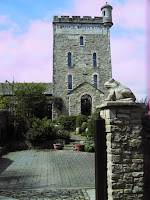T
 hanks to Stuart Goudie for contacting BWTAS about the Cammo Estate water tower near Edinburgh. The abandoned estate and its ruined 17th Century buildings are popular with walkers and a source of inspiration for many photographers, including a lovely atmospheric image by Chris Brown.
hanks to Stuart Goudie for contacting BWTAS about the Cammo Estate water tower near Edinburgh. The abandoned estate and its ruined 17th Century buildings are popular with walkers and a source of inspiration for many photographers, including a lovely atmospheric image by Chris Brown.Stuart tells us he has heard there are plans to develop the area around the estate. He doesn't know of anything about the later 19th Century tower and wondered if BWTAS can help.
There isn't any mention of this tower in Barry Barton's book (although its listings focus on the public supply) and the tower is often described as a folly although it was fully functional. It housed a lead lined wooden tank and there is photographic evidence that a windmill adorned the top that drove the pumps to supply Cammo House. One source puts the date of the tower at 1871 but this may be based on the stables nearby built by one of the estate's later owners James Watson.
Scotland's historic register doesn't give a build date but says:
Early 19th century. Circular water tower. 4 stages; string course demarcates each stage; crenallated crown. 4 blocked openings to each stage; ground floor opening to SW doorway.
The water tower supplied water to the main house. It was powered by wind and an early photo shows the tower with its sails (NMRS ED/5576/3). Along with its practical function it is likely that the Water Tower also served an aesthetic purpose: it closes the vista along the path past the stables. The water tower was part of an extensive building project undertaken by James Watson during the early 19th century. He also built the stables to the N of the tower and made alterations to the main house including the addition of a rear wing and a crenellated parapet.
References:
J Gifford, C McWilliam & D Walker THE BUILDINGS OF SCOTLAND. EDINBURGH (1984), p589-590; D Gray THE EVOLUTION OF POLICY AND PLEASURE GROUND WITH REFERENCE TO THE CAMMO ESTATE, 1993 Dissertation held at NMRS.
The anonymous blogger "Kaska" on Qype says:
I’ve met very few people that are aware of the odd tale of Edinburgh’s Cammo Estate. Cammo House existed for hundreds of years until its almost complete destruction in 1975.
Creative writers and filmmakers out there will be inspired by Cammo. It requires imagination, because fragments are all that remain of a formerly glamorous country mansion. Aside from all the history though, you can simply enjoy a walk in the fresh air. There are some lovely trees (including Edinburgh’s oldest Ash Tree) and everywhere you go you’ll discover intriguing features, such as the former horse stables, a walled garden and a water tower built in the style of a folly.
Getting to Cammo is fairly straightforward; Take a bus from the West End of Princess Street along Queensferry Road. Get off at Barnton Junction, carry along Queensferry Road and turn left into Cammo Road. The road leads to a path that takes you into the estate.
Cammo House was built by John Menzies in 1693. Each subsequent owner made additions, such as the re-designed grounds and the water canal outside the remains of the house (possibly designed by Robert Adams).
Cammo is now almost completely reclaimed by nature. An organisation called the Friends of Cammo would like to see the estate restored to its former glory, architects and city planners are still debating its future.
Edinburgh
Stuart's travels recently took him to Mannhiem Germany where he also admired the water tower there.







